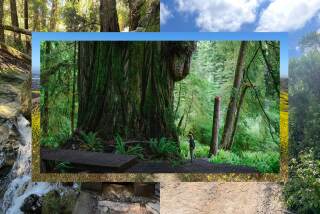Reliving Mission Days of the Past at La Purisima
LOMPOC, Calif. — Jose Antonio Ramirez was having trouble putting a sharp edge on his adz.
“We made this grinding wheel from local sandstone, but it’s not very good,” the carpenter said. “I’ve asked Father Payeras to order a better wheel to sharpen our tools.”
In a nearby room, where women with long black hair are spinning wool, master weaver Maria Mendoza is explaining what she expects of her Indian workers. “They have to make three rugs or five yards of cloth every day.”
At Mission La Purisima Concepcion de Maria Santisima, viewers can see the activities of a bygone era that comes to life on special weekends at this former Spanish missionary outpost. During Purisima’s “People Days,” costumed docents take the roles of mission residents in the 1820s.
Most pretend they are oblivious to the 20th Century, although it’s difficult for some to avoid references to the present. When an Indian girl was asked why she was spinning her potter’s wheel with bare feet, she said: “Because we don’t have L.A. Gears to wear!”
La Purisima is a state historic park and the most completely restored of California’s 21 Spanish missions.
Joe McCummins, ranger at La Purisima, gives each volunteer 44 hours training in classes that last 11 weeks. At present, there are 86 active docents--from teen-agers to 80-year-olds. They belong to the mission’s volunteer organization, Prelado de los Tesoros, which loosely translates as “Keepers of the Treasures.”
Three times every month in summer they recreate bread baking, candle and soap making, wool spinning, pottery making, nail forging and wood carving and take on other tasks in the same way that was done by the Chumash Indians and other people.
During the tortilla demonstration, children get to flatten masa (dough) and corn flour dough in a wooden press. They can watch the tortillas cook on a grill, then spoon on a topping of beans and salsa before eating them.
Also popular to youngsters is the firing of the cannon. Few notice, however, that the Spanish soldier ignites the powder with a Scripto lighter.
In the museum is a “touch” table where visitors can handle objects discovered during restoration of the mission, including clay roof tiles, water pipes and metates used for grinding corn into flour.
Guests also can hold rattles, musical flutes and other Indian-made items that belong to a Chumash descendant, Juanita Centeno, who makes sweetgrass baskets sold in the museum shop.
At her display table in the garden, Centeno said that the mission Indian women originally wore grass skirts of tule rushes. “And they went topless,” she adds. Centeno, who is half Chumash, is wearing a striped blouse over a plain cloth skirt, a sweatband and sunglasses.
White-haired Father Gomez, dressed in a blue habit, shows off his Indian-made rosary that has seashells between its beads. He also wears a badge that says “Volunteer/California State Park System,” so that visitors won’t think he is a real priest.
La Purisima Mission was founded in 1787. It honors Holiest Mary’s Immaculate Conception. First established three miles from its present location, the mission was moved after its original buildings were destroyed by earthquakes in 1812.
After Mexico took control of California from the Spanish, the missions were secularized and eventually became ruins. In the 1930s, La Purisima was rebuilt by the Civilian Conversation Corps. It is the largest and most extensively restored mission in the state.
Its isolated location in a sheltered valley on the outskirts of Lompoc offers a pastoral setting for the 967-acre park that makes the mission seem apart from today’s world. Grazing in fenced fields are cows, oxen, burros, a horse, and sheep of a breed that has been traced to the Spanish settlers.
“We shear the sheep and use their wool for our spinning and weaving demonstrations,” McCummins said. “And Beaver, our horse, can been seen on patrol around the park.”
A People Day is being held this weekend during the annual Lompoc Flower Festival, but less people are expected later in the summer on People Days scheduled July 7-8, Aug. 4-5 and Sept. 1-2. Activities are from 1 to 3 p.m.
Also, costumed docents engage in yesteryear’s chores during Mission Life Days, which will be held June 24, July 21 and Aug. 18 from 11 a.m. to 2 p.m.
Other mission events include candlelight tours Oct. 12-13 and the annual founding celebration Dec. 8. For more information, call the park office at (805) 733-3713.
Guests can take self-guided tours of the mission and grounds every day between 9 a.m. and 6 p.m. Plan at least two hours. Visit the church, cemetery, shops, soldiers’ quarters, padres’ residence, Indian barracks, kitchen end gardens.
Get a tour brochure (50 cents) or check out a free tour tape that’s available in English and several foreign languages. Entry to the park costs $1 (50 cents for ages 6-17).
To reach La Purisima Mission Historic State Park from Los Angeles, drive north on U.S. 101. Exit west beyond Santa Barbara onto scenic California 1 toward Lompoc.
Bear right at the mission sign and drive about two miles on California 246. Then turn left on Mission Gate Road that crosses Purisima Road to the parking area. There are no food facilities at the park, but picnickers can use shaded tables.
Round trip from Los Angeles is 290 miles.
More to Read
Sign up for Essential California
The most important California stories and recommendations in your inbox every morning.
You may occasionally receive promotional content from the Los Angeles Times.









